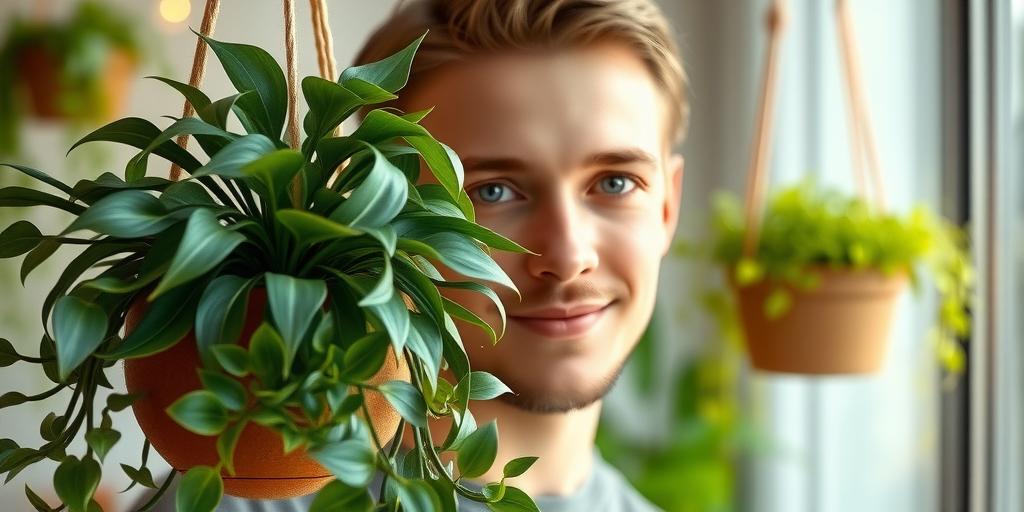
Decorate With Low Light Hanging Plants That Have Unique Foliage
Transform dim spaces with stunning low-light hanging plants featuring unique foliage! Discover the best varieties, care tips, and creative decorating ideas to elevate your home or office.
Introduction
Do you struggle with dark corners that feel lifeless? Don’t let low light stop you from adding greenery! Hanging plants with unique foliage can breathe life into any dim space while adding texture and visual interest. Whether you’re a busy plant parent or a decorating enthusiast, these low-maintenance beauties are perfect for shelves, bathrooms, or even that awkward hallway. Did you know some plants thrive better in shade than in bright light? Let’s explore the best low-light hanging plants to turn your space into a lush, leafy retreat!
Best Low Light Hanging Plants With Unique Foliage
Pothos (Epipremnum aureum)
If you’re looking for a nearly indestructible plant with eye-catching foliage, pothos is a winner. Its heart-shaped leaves come in marbled or golden patterns, adding a pop of color even in dim corners. This plant thrives in low light and can tolerate occasional neglect—perfect for beginners. Plus, it grows quickly, making it ideal for filling up empty spaces with lush greenery.
Philodendron Brasil
With its striking yellow and green variegation, the Philodendron Brasil is a showstopper. It’s a bit more compact than some other trailing plants, making it great for smaller spaces. Like pothos, it’s low-maintenance and adapts well to low light. The vibrant leaves brighten up any room, and its trailing vines can grow impressively long with minimal effort.
String of Hearts (Ceropegia woodii)
For something delicate and whimsical, the String of Hearts is a fantastic choice. Its slender vines are dotted with tiny, heart-shaped leaves that often have silvery marbling. This plant does well in bright, indirect light but can also tolerate lower light conditions—just expect slower growth. Its trailing habit makes it perfect for hanging baskets where the vines can cascade freely.
Spider Plant (Chlorophytum comosum)
A classic favorite, the spider plant is known for its arching green and white striped foliage. It’s incredibly resilient and thrives in low to moderate light. Bonus? It produces “pups” (baby spider plants) that dangle from the mother plant, adding even more visual interest. These can be snipped off and propagated to grow even more plants—great for sharing with friends!
Peperomia ‘Hope’
Peperomia ‘Hope’ is a charming little plant with thick, succulent-like leaves and a trailing habit. It’s perfect for hanging planters because of its compact size and slow growth. Unlike some other trailing plants, it doesn’t require frequent pruning to stay tidy. It prefers moderate to low light and only needs watering when the soil is dry to the touch.
Creative Ways to Display Low Light Hanging Plants
Macramé Hangers
Macramé hangers add a boho-chic vibe to any space while keeping your plants elevated. They’re perfect for pothos, philodendrons, or spider plants, allowing their vines to drape beautifully. Plus, they come in various styles—from simple knotted designs to intricate woven patterns—so you can match them to your decor.
Wall-mounted Planters
Short on floor space? Wall-mounted planters are a sleek solution. They create a living wall effect, especially when you group several together. Plants like String of Hearts or Peperomia ‘Hope’ look stunning in these setups. Just make sure they’re securely anchored, especially if you’re using heavier pots.
Floating Shelves
Floating shelves let you layer different trailing plants for a lush, dimensional look. Mix textures and colors—like pairing a spider plant with a pothos—to create visual contrast. Shelves near windows (even in low light) help maximize the available sunlight while keeping your plants at eye level for easy admiration.
Glass Terrariums
If you love humidity-loving plants like ferns, glass terrariums are a stylish way to display them. The enclosed environment helps retain moisture, making them ideal for delicate species. Hang a small terrarium near a window (but out of direct sun) for a mesmerizing mini-ecosystem.
Ceiling Hooks & Baskets
For a dramatic effect, hang plants directly from the ceiling using hooks and baskets. This works especially well for long, trailing plants like String of Hearts or philodendrons. Choose lightweight baskets to avoid strain on your ceiling, and adjust the height based on how much you want the vines to cascade.
Essential Care Tips for Low Light Hanging Plants
Watering
Overwatering is the fastest way to kill a low light plant. Since these plants get less light, they dry out slower. Always check the soil before watering—stick your finger in about an inch deep. If it feels dry, it’s time to water. If not, wait a few more days.
Fertilizing
Low light plants grow slower, so they don’t need as much fertilizer. A diluted liquid fertilizer every 4-6 weeks during the growing season (spring and summer) is plenty. Skip fertilizing in winter when growth naturally slows down.
Pruning
If your plant starts looking leggy (long stems with sparse leaves), don’t hesitate to prune it. Trimming back the vines encourages bushier growth. You can even propagate the cuttings to grow new plants—just place them in water until roots form, then replant.
Cleaning Leaves
Dust can block light absorption, which is already limited in low light conditions. Wipe leaves gently with a damp cloth every few weeks to keep them clean and efficient at photosynthesis.
Rotating Pots
Plants in low light tend to grow toward the light source, leading to uneven growth. Rotate the pot every couple of weeks to ensure all sides get equal exposure. This keeps the plant balanced and full.
Common Problems & Solutions
Yellow Leaves
Yellow leaves usually mean overwatering or poor drainage. Check if the pot has drainage holes and let the soil dry out more between waterings. If the roots are mushy, you may need to repot in fresh soil.
Leggy Growth
If your plant is stretching out with long gaps between leaves, it’s craving more light. Move it to a slightly brighter spot (but still indirect light) or supplement with a grow light. Regular pruning can also help maintain a compact shape.
Pests (Spider Mites, Mealybugs)
Hanging plants aren’t immune to pests. Spider mites and mealybugs love dry conditions. If you spot tiny webs or white cottony patches, treat the plant with neem oil or insecticidal soap. Isolate the affected plant to prevent pests from spreading.
Slow Growth
If your plant seems stagnant, it might be root-bound or lacking nutrients. Check if roots are circling the pot—if so, repot into a slightly larger container. A light dose of fertilizer can also give it a boost.
Brown Tips
Brown leaf tips often signal low humidity or chemicals in tap water. Try misting the plant occasionally or using filtered water. If your home is very dry, grouping plants together can create a more humid microclimate.
By choosing the right plants, displaying them creatively, and following these care tips, you can enjoy lush, thriving greenery—even in the dimmest corners of your home.
Conclusion
Who says dark spaces can’t be vibrant? With the right low-light hanging plants, even the dimmest corners can become lush, eye-catching focal points. From the cascading beauty of String of Hearts to the bold patterns of Philodendron Brasil, there’s a perfect plant for every style. Ready to transform your space? Pick your favorite, hang it up, and watch your home come alive!
